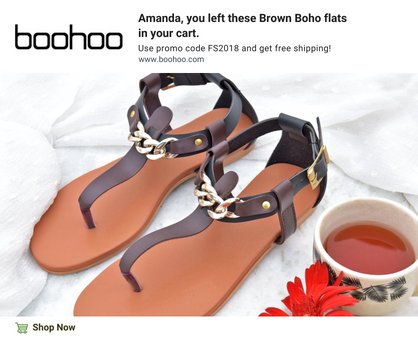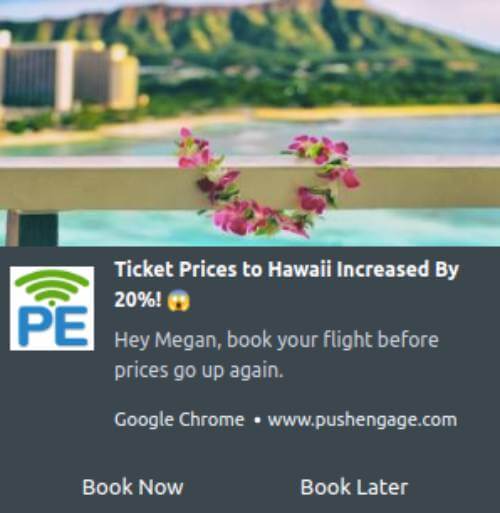One of the most common questions we get is about when to use push notifications.
But we love it when marketers ask when not to use push notifications!
Honestly, push notifications are some of the most epic ways to convince and convert your audience. The amazing part is that you can do it on complete autopilot.
But most businesses send way too many notifications. And most subscribers end up completely ignoring notifications altogether.
That’s why in this article, we’re going to give you a cheat sheet on when to use push notifications and when not to use them.
If you stick to the guidelines in this article, you will see higher engagement and conversion rates from your push notifications. And if you ignore this epic guide…
Well, we’ll be very unhappy because we worked pretty hard to create this guide for you.
Also, you’re going to keep losing subscribers and over time, your push notifications will stop working altogether.
Not cool. Are you ready to get better engagement and conversion rates?
Then, let’s dive in.
What Are Push Notifications?
Push notifications are small popups that show up on either mobile devices and PCs or a browser on any device. The best part is that it’s a clickable popup that you can receive when you come online.

In other words: push notification is a simple way to send out a clickable link to your content to anyone who opted in. For a detailed guide on the basics of push notifications, check out our simple guide to push notifications.
When To Use Push Notifications
Let’s get into the core idea behind this article, which is…
When should you use push notifications? There are some very specific use cases where push notification can be really impactful.
Push notifications are designed to be disruptive in nature. They interrupt your schedule when you receive them. So, in order for push notifications to be high-performing, you need to stick to certain principles and formats.
Let’s take a closer look at these formats now.
Reducing Abandoned Carts
Abandoned carts are a major problem with all eCommerce stores. Visitors will love your product, add it to their cart, and then never buy it. To reduce cart abandonment, you can use push notifications like this one:

And yes, you can add personalization to your notifications such as the customer’s name. But more on that later. For now, you should definitely check out our article on how to set up abandoned cart push notification campaigns.
If you’re not running an eCommerce store, you can still use the idea of cart abandonment to improve your conversions. Here’s a nice example from a flight booking app:

Cart abandonment campaigns work really well with push notifications.
And it’s no mystery why: cart abandonment campaigns are meant to be disruptive and attract eyeballs. Here, a push notification is relevant, personal, useful, and doesn’t feel pushy.
Pro-Tip: You can use many different ways to reduce abandonment rates. Use push notifications along with a few other ideas. If you’re looking for inspiration, you can check out our article on reducing cart abandonment.
Sending Urgent News Alerts
Urgency has always been a great way to sell. But for push notifications, a really great format you can use is urgent messaging. It depends on your business what qualifies as “urgent”.
If you’re running a news portal, a notification about a hurricane would definitely be urgent:

For a flight booking company, a price drop or price hike notification is pretty urgent:

For any small business, this will probably be very familiar:

And for eCommerce sites, sale promotions would be another perfect example of urgent notifications because sales usually have an expiry date.
And this is the perfect occasion to use push notifications. Delivering urgent news at the right time to the right people can help build a brand that people trust and WANT to hear from.
The best part is that you can make a lot of extra revenue by simply sending useful notifications at the right time.
Pro-Tip: If you’re looking to increase your monthly revenue, you should check out our article on sales promotion examples.
Showcasing New Content
There’s only one excuse to breaking the rules for urgency and usefulness: UNIQUENESS.
If you have content that’s truly unique and you know that your audience (or a segment of your audience) will find it interesting, you should use push notifications to promote it.
Spotify does this really well:

But you don’t really have to be a giant like Spotify to use this idea.
In fact, the beauty of push notifications is that they can give you a level playing field even if you’re just starting out. If you’re not sure how to get started, you should check out this article on creative push notification campaigns.
Increasing User Retention
One of the biggest spends in digital marketing nowadays is lead generation advertising. Yes, lead generation is really important. But it costs a business way more to acquire a new customer than it does to retain existing customers.
The sad part is that most businesses don’t focus on retention as much.
Even in the app business, people generally focus on the number of people who installed the app. That’s a big mistake. What you want to look at is daily active users instead.
It’s the same thing with your website.
What you want is to focus on ways to engage your subscribers.
When Not To Use Push Notifications
Now that we have some ideas on when you should use push notifications, let’s take a quick look at when you should not use push notifications.
Some of these instances are just bad ideas. Others are straight-up horrible and can have long-term impacts on your business.
Let’s dive in.
Advertising Products From Other Businesses
The one thing you should never do is advertise products from other businesses. It feels completely spammy and can lead you to lose a bunch of subscribers immediately.
And this is a major problem for many publishers that run on affiliate commissions.
Some publishers even go so far as to use some Google alternatives to serve ads. This can permanently damage your credibility and it’s a very bad idea to serve ads using push notifications.
There is only one exception to this rule.
If you’ve actually tried out the product and you can whole-heartedly endorse it, then you could promote it using push notifications.
But even so, you have to take care to never come off as spammy. It’s really difficult to do this because push notifications have a strict character count. So, you can’t say a lot in one push notification. Best avoid this idea altogether.
Messages that Don’t Provide Value
This is probably a no-brainer, but you’d be surprised how many marketers forget about this rule altogether. Before sending your audience any message, think it through…
Is it something:
- Urgent?
- Unique?
- Useful?
- Ultra-specific?
If your push notification doesn’t fit any of these buckets, it’s not a notification you should be sending in any case.
Messages that add value don’t necessarily have to be an offer or a promo. You could just be helpful like Waze:

It’s just that simple!
Acquiring New Traffic
Technically, you CAN’T acquire new traffic using push notifications.
Push notifications work on a subscription basis. So, anyone who’s subscribed to your push notifications has already visited your site before. A common mistake that people make when they get started with push notifications is assuming that they will get a boost to website traffic.
The reality is that you can get only repeat traffic using push notifications.
Over time, what happens is that the overall traffic to your site increases because of two reasons:
- The repeat traffic that you get from push notifications will keep getting social shares
- The added traffic to pages with low traffic will eventually boost the SEO on your site
Both these channels have the potential to get you new traffic. But this is a long-term indirect outcome. It’s really not fair to say that push notifications got you that traffic.
Wrapping Up
That’s all for this one, folks!
Did this article help you fine-tune your push notification campaigns? Let us know in the comments below. If you’re new to push notifications, you should check out our article on push notification best practices.
And you should definitely try our PushEngage. PushEngage is the best push notifications software in the market. Whether you’re new to push notifications or a seasoned veteran, there’s some feature you’ll fall in love with.
So, if you haven’t already, get started with PushEngage today!

Excellent article with helpful graphics. Thanks for defining push notifications for me. I will likely incorporate them myself whenever I resurrect my own website!